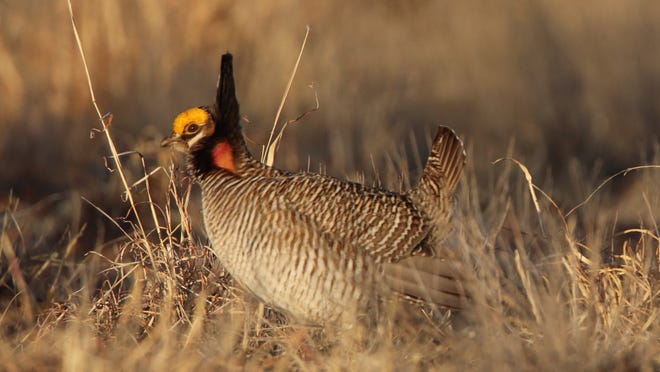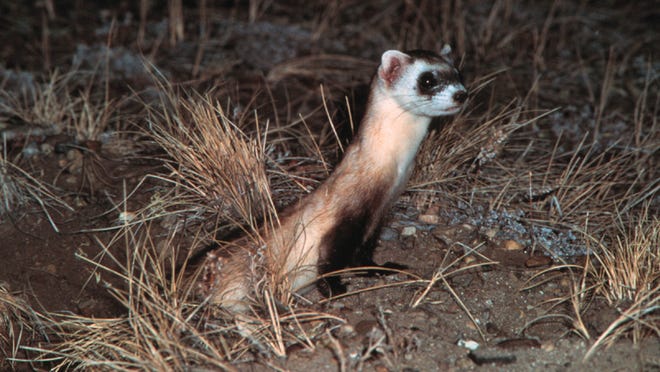Oil and gas impacts lead to lawsuit for federal action on lesser prairie chicken protection
 Adrian Hedden
Adrian Hedden
Lesser prairie chickens once numbered in the million across the American West, known for their unique mating dances on the prairies of southeast New Mexico and other states.
Restoring that historical populace was debated for years in court, with a recent lawsuit aiming to compel the federal government to act.
In recent years, the species suffered dwindling numbers brought on by industrial development in the oil and gas and agriculture sector fragmenting the wide-open prairies the bird needs to survive.
More:Native flower extinct in New Mexico could be brought back through federal protections
That’s why the U.S. Fish and Wildlife Service announced last year it was considering providing protections for the chicken in two separate population segments.
It was proposed to be listed as “endangered” in a southern region, including portions of southeast New Mexico and West Texas, and “threatened” in a northern population segment that includes several other states like Oklahoma, Colorado and Kansas along with the northern Texas panhandle.
Endangered is the highest class of species protection defined in the Endangered Species Act, implying extinction is imminent, requiring recovery plans and restricting certain activities in areas designated as critical habitat where and endangered species lives or could expand its range.
More:Funds on the way for New Mexico's endangered species through US Senate bill, grants
Threatened status triggers some but less federal action to restore an animal’s population.
The Fish and Wildlife Service had yet to issue a 12-month finding on the two listing proposals for the northern and southern distinct population segments (DPS) that was due in June, a failure that caused the Center for Biological Diversity to notify the service and courts the agency planned to sue within 60 days to compel the required decision.
Michael Robinson with the Center for Biological Diversity criticized the agency for another postponement, he said, after decades of delays to protect the imperiled bird.
More:New Mexico ranchers take on national environmental group over protections for rare bird
“Lesser prairie chickens have already waited nearly 30 years for protection, all the while losing habitat to oil, gas and other development,” Robinson said. “Every new day without protection brings this rare dancing bird closer to extinction.”
He argued environmental impacts to the lands the chicken needs to live and thrive fragmented its habitat, and development added infrastructure that could impede breeding.
Lesser prairie chickens are known to avoid tall structures like drilling rigs or telephone poles where prey could perch, meaning such developments restrict their movement and shrink their range.
More:Oil and gas threatens lizard native to southern New Mexico. Here's what's being done
They are also impacted by rising temperatures brought on by greenhouse gas pollution that can damage eggs and hatchlings.
“As a result of these increasingly common manmade structures, the birds have a rapidly diminishing number of places to live,” read the Center’s notice of intent to sue.
“The lesser prairie chicken’s decline has also been fueled by the degradation and fragmentation of the vast southern Great Plains through conversion to cropland, grazing of cattle, and oil and gas development, as well as drought and high temperatures linked to global warming.”

More:Federal agency begins work to restore New Mexico's last native mussel near Carlsbad
Robinson said oil and gas, which contributes both air pollution and increased physical infrastructure to the lesser prairie chicken’s habitat, presents a “double threat” to its survival.
“Fossil fuels are a double threat to the lesser prairie chicken,” he said. “They’re a leading cause of habitat loss, and the main cause of the warming that’s making the world increasingly inhospitable for these special birds, and all of us, too.”
The Fish and Wildlife Service listed the chicken as threatened in 2014, after a petition from the Center for Biological Diversity in 1995 and a series of lawsuits, but the listing was vacated after challenges from the oil and gas industry.
More:New Mexico oil and gas industry prepares for federal restrictions to conserve rare chicken
The Center petitioned for the species to be listed as endangered in 2016, then sued again in April 2021, leading to the latest proposal.
In the notification of intent to sue, the Center said the Fish and Wildlife Service and parent agency the U.S. Interior Department and Interior Secretary Deb Haaland had so far failed to adequately protect the bird as required by federal law.
“The Service has abrogated its duty to ensure that the Southern DPS and Northern DPS of the lesser prairie chicken are timely protected, in violation of Section 4 of the ESA,” read the notice.
“If the Secretary does not timely finalize this rule or contact us to develop a timeline within the next 60 days, the Center intends to file suit to enforce the Act.”
More:Delay on federal protections for native southeast New Mexico flower prompts lawsuit
Listing the lesser prairie chicken, and the potential restrictions on development that could follow, became controversial as leaders and supporters of industries like oil and gas and agriculture argued such federal action could stymie development which they said was crucial to New Mexico’s economy.
The southern DPS, where the toughest restrictions could be should the proposal be enacted, covers portions of the Permian Basin – the U.S.’ busiest fossil fuels region that makes up almost half of total American crude oil output.
Eddy County commissioners, in a letter to the Fish and Wildlife Service upon its publication of the initial proposal, argued the oil and gas industry and other land users already took adequate steps to prevent impacts to the chicken.
Those efforts took the form of candidate conservation agreements − contracts between land users and the Fish and Wildlife Service that entail landowners taking specific conservation efforts in exchange for limiting future restrictions should a listing be enacted.
The Center for Excellence (CEHMM), a Carlsbad-based non-profit, that facilitates these agreements, reported in the second quarter of 2022 several projects were complete to remove tall structures like windmills from the chicken's range, and add fencing to prevent encroachment on its habitat.
CEHMM's records show about 2.5 million acres of land were enrolled in the agreements for lesser prairie chicken protection including industry, government and privately-owned lands.
“Eddy County believes that conservation efforts put on the ground through various industry efforts to enhance the habitat for the LPC in New Mexico over the last several years will show that the overall trend for the bird is improving and that a listing decision as endangered is not warranted,” the letter read.
Adrian Hedden can be reached at 575-628-5516, achedden@currentargus.com or @AdrianHedden on Twitter.